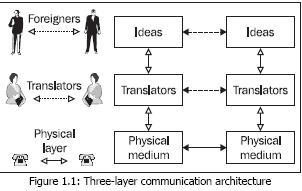|
Book Excerpt: Introduction to Network Protocols
Chapter Contents
|

|
This excerpt from
Understanding TCP/IP: A clear and comprehensive guide to TCP/IP protocols
by Libor Dostálek, Alena Kabelová, is printed with permission from
Packt Publishing
, Copyright 2007.
|
Just as diplomats use diplomatic protocols in their meetings, computers use
network protocols to communicate in computer networks. There are many network
protocols in existence; TCP/IP is a family of network protocols that are used
for the Internet.
A network protocol is a standard written down on a piece of paper (or, more
precisely, with a text editor in a computer). The standards that are used for
the Internet are called Requests For Comment (RFC). RFCs are numbered from 1
onwards. There are more than 4,500 RFCs today. Many of them have become out of
date, so only a handful of the first thousand RFCs are still used today.
The International Standardization Office (ISO) has standardized a system of
network protocols called as ISO OSI. Another organization that issues
communication standards is the International Telecommunication Union (ITU)
located in Geneva. The ITU was formerly known as the CCITT and, being founded
in 1865, is one of the oldest worldwide organizations (for comparison, the Red
Cross was founded in 1863). Some standards are also issued by the Institute of
Electrical and Electronics Engineers (IEEE). RFC, standards released by RIPE
(Réseaux IP Européens), and PKCS (Public Key Cryptography Standard) are freely
available on the Internet and are easy to get hold of. Other organizations
(ISO, ITU, and so on) do not provide their standards free of charge—you have to
pay for them. If that presents a problem, then you have to spend some time
doing some library research.
|
|
First of all, let's have a look at why network
communication is divided into several protocols. The answer is
simple although this is a very complex problem that reaches across
many different professions. Most books concerning network protocols
explain the problem using a metaphor of two foreigners (or
philosophers, doctors, and so on) trying to communicate with each
other. Each of the two can only communicate in his or her respective
language. In order for them to be able to communicate with each
other, they need a translator as shown in the following
figure:

The two foreigners
exchange ideas, i.e., they communicate. But they only do so
virtually. In reality, they are both handing over information to
their interpreters, who then transmit this information by sending
vibrations through the surrounding air with their vocal cords. Or if
the parties are far away from each other, the interpreters
communicate over the phone; thus the information is physically
transmitted over phone lines. We can therefore talk about virtual
communication in the horizontal direction (philosophical
communication, the shared language between interpreters, and
electronic signals transmitted via phone lines) and real
communication in the vertical direction (foreigner-to-interpreter
and interpreter-to-phone). We can thus distinguish three levels of
communication:
1. Between two
foreigners
2. Between interpreters
3. Physical transmission of information using
media (phone lines, sound waves, etc.)
Communication between
the two foreigners and between the two interpreters is only virtual.
In fact, the only real communication happens between the foreigner
and his or her interpreter.
Even more layers are
used in computer networks. The number of layers depends on which
system of network protocols you choose to use. The system of network
protocols is sometimes referred to as the network model. You most
commonly work with a system that uses the Internet, which is also
referred to as the TCP/IP family. In addition to TCP/IP, we will
also come across the ISO OSI model that was standardized by the ISO.

The TCP/IP family uses four layers while
ISO OSI uses seven layers as shown in the figure above. The TCP/IP
and ISO OSI systems differ from each other significantly, although
they are very similar on the network and transport layers.
Except for some exceptions like SLIP or
PPP, the TCP/IP family does not deal with the link and physical
layers. Therefore, even on the Internet, we use the link and
physical protocols of the ISO OSI model.
Page 1 |
Page 2
|
page 3
|
page 4 |
page 5
|